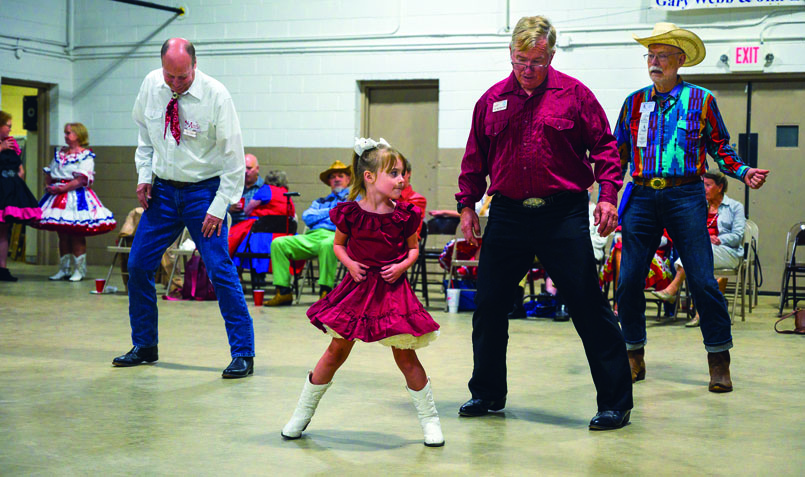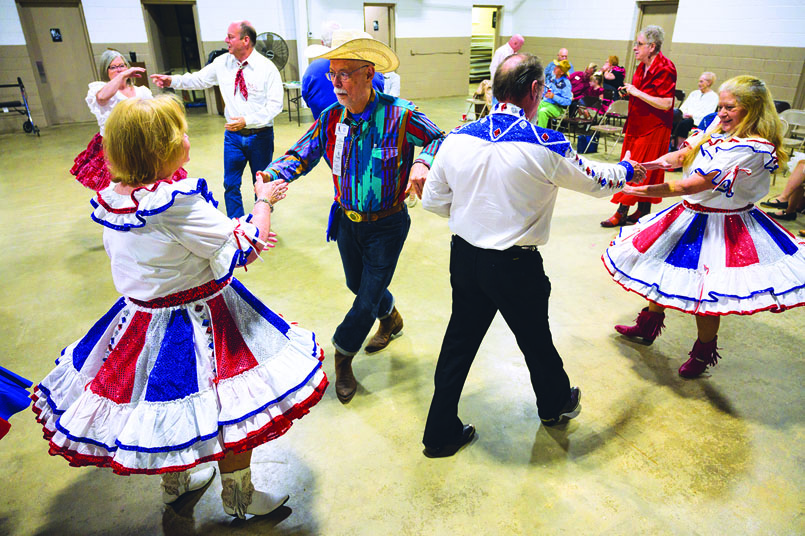27 Oct 2021 Hip to be Square
By Dwain Hebda
Gordon White clicks a couple of keys on his computer and grins. In a few seconds, a smooth instrumental starts playing, something you might hear at a cocktail party or jazz festival. He waits a few beats.
“Bow to your partner … to your corner you-all … four ladies change … gents promenade, half-way … down the middle with a right-left through … rollawaaaayyyy. … ”
White’s mellow patter snugs into and on top of the beat, smooth and silky. He’s not rapping, though it’s not far from it. What he’s doing is square dance calling and whether you know your allemande from your do-si-do, the lyrical performance is honey on the ears.

“A good caller will analyze the floor within the first step or within the first five or ten minutes and then the caller should have the ability to push people just to the edge without breaking them down,” he said. “Just kind of nudge them along with some calls that might be a little more challenging, let’s just say.”
White has nudged and been nudged in the art of square dancing, along with his wife Sue, for just shy of 50 years. The couple began dancing in their native upstate New York and through the years, combined their hobby with a passion for travel. Today they can boast of having danced the world over, from Russia to South Africa. Even now, having relocated to Hot Springs Village where they’re members of the Diamond Squares, the Whites’ upcoming calendar is jammed with trips and cruises where they will dance in the U.S., abroad and on the high seas.
“It’s mental stimulation and it’s physical, because you’re going to walk three miles in an evening at 128 beats a minute,” he said of square dancing’s enduring appeal. “It’s social, something done that’s healthy. Just holding hands when you square dance, holding hands is therapeutic.”
If your notion of square dancing runs toward gingham and hay bales, you’re woefully behind the times. The American art form is practiced to all kinds of music, in all 50 states and, as the Whites attest, more than 30 countries. There are almost 5,000 “calls,” which are dance maneuvers a caller strings together during the course of a song. Meaning, unlike the rigid 1-2-3 of a waltz, square dancing to the same song by different callers can result in two very different sets of steps.
Carolyn Birdsong of Ferndale discovered square dancing in the 1990s and has been active since, to the point of becoming a caller herself. She said one appeal of square dancing is it can be learned by anyone.

“It’s something so good, it’s hard to describe,” she said. “It’s just walking. Square dancing is just walking. People think you’ve got to have rhythm. No, you don’t have to have rhythm. It exercises your brain, too, because you have to think about what you’re doing.”
Birdsong muses on several club affiliations throughout her career, each one eliciting warm memories of times shared and lifelong friends made. She founded her current club, Bluebird Squares in Benton, partly inspired by her last name, in the hopes of helping revive interest in the art form locally.
“Twenty years ago, when I first joined a local club, they had 150 members,” she said. “I don’t know what it is now, but the numbers definitely have dropped. It’s really sad because it is such a wonderful thing. But some people just don’t want to make the commitment to take lessons for three months to learn 50 moves. And, as we get older, it takes us longer to learn, too.
“But it’s funny; a lot of people who did it a long time ago now have time, so they’re coming back. Well, that’s fine. With my club, I tell ’em, ‘Come and dance. Don’t worry about anything, just come and dance.’”
- The pinnacle of success - June 1, 2025
- Five-Oh-Ones to Watch 2025: Aaron Farris - December 31, 2024
- Julia Gaffney brings medals and mettle home to Mayflower - October 30, 2024








